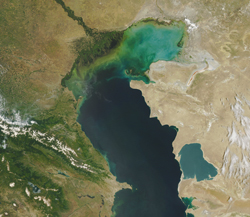|
Vol. 232 No. 2 |

|
|
HENRY TERRELL, CONTRIBUTING NEWS EDITOR
|
Big potential, tough going, for the big lake
The Caspian Sea is the world’s largest freshwater lake, depending on your definition of “lake.” If you take the commonly accepted “body of (usually fresh) water surrounded by land,” then the Caspian qualifies. The water is “fresh” only in a sense, though. Salinity varies greatly from north to south, from very low where the Caspian is fed by the Volga and many other smaller rivers, to near-ocean salinity in the south where it borders on Iran. The Garabogazköl embayment, that little bump that sticks out on the eastern side (see photo) is salty indeed, about 10 times as much as seawater.
 |
Kashagan Field lies in the central part of the shallow North Caspian, which endures crushing ice in the winter.
|
|
If you call the Caspian a sea, with its 143,000 sq mi of water surface, nobody is going to argue with you. It is divided into three distinct regions: the south, which has deep waters (sometimes exceeding 3,000 ft), the middle region, with an average depth of about 600 ft, and the North Caspian, which is essentially a very, very large puddle. As you can tell from the satellite photo, the area is quite shallow (only 15 to 20 ft deep). Many times in its history it has dried up completely, leaving a layer of evaporite like the Bonneville salt flats in Utah.
Too hot, too cold. It is not a terribly pleasant place. Although it sits at a latitude comparable to the French Riviera, it is far from a temperate climate. Bounded by deserts and swampy wetlands, below sea level, the North Caspian is hot and humid in the summer, with legendary (and malaria-carrying) mosquitoes, and in the winter it freezes solid.
Not to get all James Michener on you, but the geological history of the area is important. For most of its existence, going back to the ancient days of Gwandonaland, the region has been a shallow continental sea. Marine organisms by the billions and trillions have lived and died and dropped to the bottom to be buried in silt. These formed large sedimentary basins, and that’s what makes the region interesting, from an international energy perspective.
Kazakhstan. The North Caspian lies within the nation of Kazakhstan, a vast country that sits on the imaginary dividing line between Eastern Europe and Central Asia. The ancient land that became Kazakh has been continually inhabited for thousands of years. Following its conquest by the Russian empire in the 19th century, it became the place where people were sent involuntarily, both as exiles and as colonists, a practice that continued into the Soviet era. Hence, the modern Kazakhs are a hardy people with wide cultural diversity.
Tengiz. In the time of the Czars, the country was known for its coal resources. In 1979, while still part of the Soviet sphere, the first major oil discovery was made on the wetlands of the North Caspian. Tengiz Field, with some 25 billion bbl of oil in place, was the sixth largest oil field in the world. Although the oil is abundant, it is also high in sulfur, and the removal and handling of this contaminant has been particularly challenging. Tengiz also holds a considerable amount of natural gas, though it is very sour, with lethal levels of hydrogen sulfide. Soviet efforts to develop the field were mostly haphazard. The first exploratory well to hit serious paydirt in 1986 resulted in a gas blowout that was so difficult to handle, at such tremendous pressure and with high levels of poison gas, that it burned for over a year before finally being extinguished and capped by Red Adair.
After Kazakhstan gained its independence in 1991, interest in petroleum exploration heated up. The new nation sought out foreign help, and after three years of negotiation, the Kazakh government signed a PSA with Chevron subsidiary Tengizchevroil to invest some $30 billion over four decades. At first, the government controlled 50% of the project, but with the desperate economic conditions that Kazakhstan found itself in during the early ’90s, they were compelled to sell of most of their stake to foreign companies. This was a humbling lesson they never forgot.
Kashagan. In 2000, Kashagan Field was discovered, with estimated commercial reserves ranging from 9 billion to 16 billion bbl. Located in the central North Caspian, it is actually five fields, Kashagan, Kalamkas A, Kashagan SW, Aktote and Kairan. The find has the potential to make Kazakhstan a heavyweight oil exporter, but its development has been stymied by production delays and budget overruns. Kashagan has not yet produced a commercial barrel of oil.
To develop the field, the Agip KCO consortium was created, consisting of Eni, ExxonMobil, Royal Dutch Shell, Total, ConocoPhillips, Inpex and KazMunaiGaz, the national oil company.
The start date for Kashagan production was pushed back repeatedly, from 2005 to 2008, then 2010. The Kazakh government accused the consortium of breach of contract and violating environmental regulations. It revoked Eni’s operating license, and demanded a $40 billion bonus and an increased share in Kashagan. It also threatened to fine the consortium for environmental damage. Project costs increased from $57 billion to $136 billion. A new joint operating company, North Caspian Operating Co. (NCOC), became operator. First production was pushed back to late 2012 (and not everyone believes that). NCOC announced that Phase II development would be delayed until 2018. The plan is to boost production to 1.5 million bpd by 2021, but that date is also in doubt.
The government’s heavy-handed dealing with NCOC has led some observers to speculate on the possibility of a Putin-style takeover. But despite all the suspicion and ill will on both sides, there is a lot at stake for both Kazakhstan and the companies. With all the challenges on the big lake, they need each other. 
|




